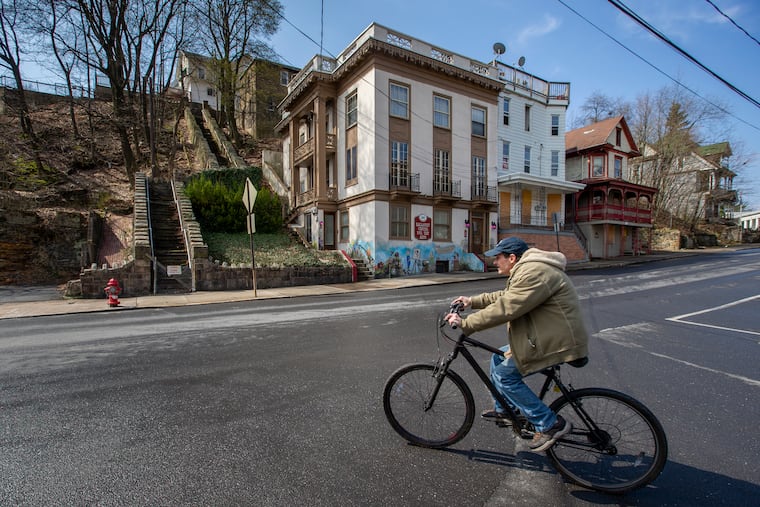Pennsylvania’s post-industrial, public steps could use some love and attention
Shamokin's "99 Steps" was built by FDR's New Deal and has been closed since 2008.

SHAMOKIN, Pa. — Stairways were always rising and falling in Pennsylvania’s industrial towns.
Long, wooden steps carried workers down to the mills in Manayunk and businesses in Jim Thorpe, then back up to their homes in the hilly streets at night. Over the centuries, wood was replaced by stone, then patched with concrete, then barely maintained at all in some towns. Today, many stairways, like the majestic, stone “99 Steps” in this Northumberland County coal town, are closed and crumbling.
The stairs have been closed since 2008, but in November, a sign affixed to a gate there was switched from “Closed” to “Steps close to be being fixed!”
Saving those steps — which actually number 88 — has become a passion project for two women with Shamokin roots. One of them, Allison Williams, used to climb the stairs every day as a child. The other, Kathy Vetovich, has been trying to pump life back into the hardscrabble town 130 miles northwest of Philadelphia. Vetovich, president of the Shamokin Area Business for Economic Revitalization (SABER), owns several properties downtown, and turned a former church into a coffeehouse at the base of the stairs. Shamokin has nine sets of public stairs, and Vetovich said they should be signs of life, not grave markers of the past.
“Functionally, they used to be used by thousands of people, but the pride is the biggest motivator for me,” Vetovich said.
SABER is asking people to “Step up” and donate, via Paypal, to the renovation of the 99 Steps, which the group says will cost $200,000. They’ve raised $20,000 so far. First built in 1914, the stairs were rebuilt, by hand, with stone by Franklin D. Roosevelt’s Works Progress Administration in the early 1940s. Much of that stone still stands today and SABER hopes to preserve some parts of the original work when they’re replaced.
“I decided it was time for me to come out of retirement and help,” Williams, the project coordinator said. “They’ve always been part of my life.”
Maintenance of public stairways often falls on municipalities. That includes everything from snow removal to structural repairs. In Shamokin, which is exiting Pennsylvania’s ACT 47 status as a financially distressed city, the 99 Steps proved to be too much. It’s unclear whether the city will contribute to the fund-raiser. Mayor Dave Brown did not return requests for comment.
In other towns, like Jim Thorpe, there’s been a debate over who owns specific stairways and, more importantly, who’s liable for the insurance. Tom Loughery, who owns an apartment building in the Carbon County tourist town, is in litigation with the borough over ownership of the concrete stairs by his building.
“The borough built these steps and paid for them in the 1880s and maintained them ever since,” he said. “In 2017, they told me ‘Hey, you’re responsible now. Good luck.’ ”
Loughery said he would be unable to insure the stairs, which were closed in 2017, and believes Jim Thorpe is trying to pass responsibility for public infrastructure to a private landowner.
“We’re currently digging into property records from the 1800s,” he said.
In Philadelphia, Manayunk is home to approximately a dozen stairways, often built by the mill workers themselves in the 1800s, and are serviced by the city’s Streets Department. Like all public stairways, they’ve been used less as people began to drive, but Manayunk’s steps have their own, small group of supporters.
“When I lived there, I got really into them,” said Ellen Grupe, who now lives in mostly-stairless Jersey City. “Maybe I was the only one.”
Grupe, who lived near Manayunk’s largest staircase on Gay Street, used to host tours of the staircases. Handfuls of people showed up, she said.
“I know this is crazy but I actually stood at the bottom of the Roxborough Avenue stairs and surveyed people to see why they used them,” she said. “People said they make the city more walkable and they’re great for exercise.”
Grupe was not alone in her love for Manayunk’s staircases. Attorney Eliot Duhan started the “Stairs of the Schuylkill Valley” Facebook group and hopes, one day, to have a one-day stairs festival there.
“They were the first form of public transportation,” Duhan said. “I can’t believe there isn’t a T-shirt or a poster available with our stairs on them.”
In Shamokin, where its nine staircases were studied by a Bucknell University class’ research project, stair aficionados are simply longing to replace the gate blocking the 99 Steps with a reopening ribbon they can cut.
“Every day, I took these stairs,” Williams said after climbing them. “It’s not as easy as it used to be.”